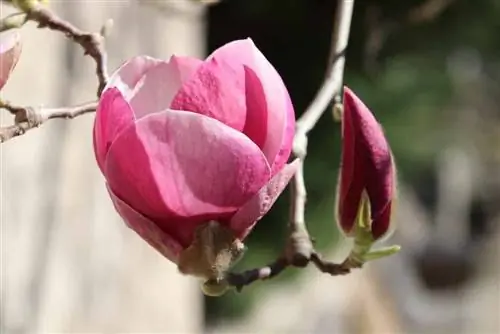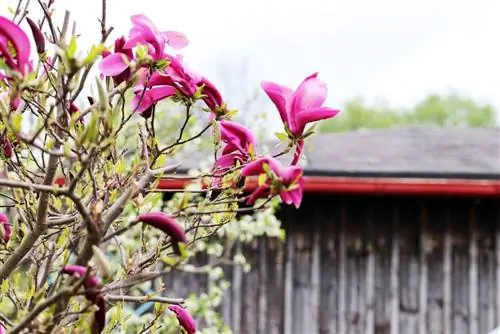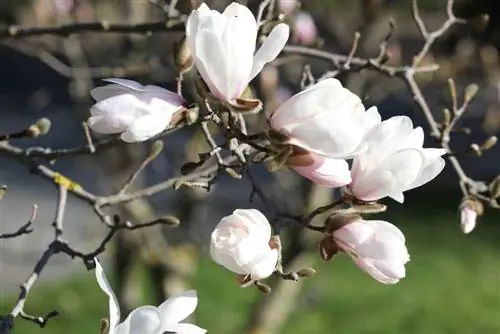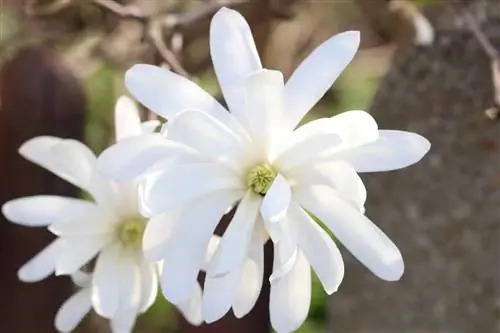- Author admin [email protected].
- Public 2023-12-17 03:39.
- Last modified 2025-01-24 12:45.
Depending on the species and cultivation form, magnolias reach very different heights. Many types of magnolia are large shrubs, others grow as sprawling trees that can reach heights of up to 25 meters when they are old. Almost all varieties shed their leaves in autumn and go into hibernation. An exception is the evergreen magnolia, which retains its foliage all year round. However, this species is a little more sensitive to cold than others. If the location and soil conditions are right, a magnolia tree does not require any special care and is quite robust.
Short profile
- Botanical name: Magnolia
- other names: magnolia tree
- form a separate genus within the magnolia family (Magnoliaceae)
- growing rather slowly
- loose crown structure
- Growth: as a shrub or tree (3 to 25 meters high)
- Flowers: some species in April, others in May/June
- mostly white, rarely pink, purple or yellowish
Occurrences
Magnolias, botanically magnolia, grow as shrubs or trees in a total of 220 different species. Their natural range extends from North America through the Caribbean and South America to East Asia. There are magnolia species that shed their leaves in autumn but also a few evergreen species. Magnolias are among the oldest flowering plants on earth. Together with the North American tulip tree, they form the magnolia family. They have long had a permanent place as an ornamental plant in gardens and parks around the world. Unfortunately, due to the increasing agricultural use of their habitats, around half of all species in nature are threatened with extinction.
Location
Magnolias originally come from Asia and America, but not necessarily from the same climate zones. While some species are naturally accustomed to icy winters, others come from Mediterranean or subtropical regions. These magnolia trees can therefore only be planted outdoors in warm winter regions (such as wine-growing regions). Many new varieties of these magnolias are now available with improved winter hardiness. Most types of magnolia prefer a bright location in the garden, which ideally also provides protection from the midday sun.
- Light requirements: rather sunny, some species prefer to be shaded around midday
- most species also cope well with partial shade
- Soil: humus, good storage capacity for water, rich in nutrients
- most species prefer acidic soil
- protected from the wind if possible
- Southeastern and western locations are ideal
Tip:
Small magnolias can also be grown in pots. In this case, a very high-quality pot substrate and a sufficiently large container are necessary. Potted plants are overwintered cool but frost-free.
Plants
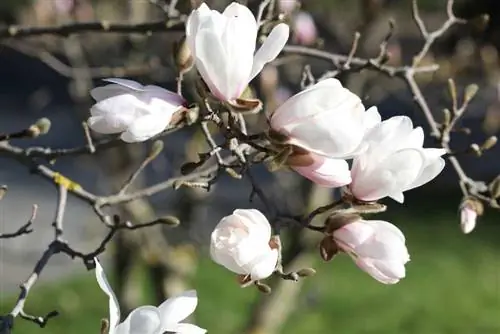
The best time to plant a magnolia tree is spring. This gives the plant enough time to root itself well in the soil before winter comes. The planting hole should always be dug very generously and the soil should be improved with humus and acidic soil.
- Time: Spring
- Planting hole: three times the bale width and depth
- Loosen the soil well at the bottom of the planting hole
- mix peat, ericaceous soil or rhododendron soil into the excavation
- add sand or grit for very heavy soils
- possibly install a tree support
- pour well
- Always pay attention to moist soil in the following weeks
Tip:
When choosing the type of magnolia, it is important to pay attention to the space available in the garden. While a magnolia that grows as a shrub is suitable for small gardens, a magnolia tree requires a lot of space and should be planted with sufficient distance from buildings and property boundaries.
Pouring
All magnolia trees are very sensitive to drought. That's why they need to be watered regularly. If the tree lacks moisture for a long period of time, it reacts by shedding more leaves. The drying out of the soil can be significantly reduced by incorporating larger amounts of humus-rich soil that stores water well when planting. In addition, a thick layer of mulch protects against excessive heat and drying out in the root area. Even better than mulch is appropriate underplanting of the magnolia with ground cover plants.
Tip:
Strong-rooted bushes and perennials must not be planted under the magnolia as they compete with the roots of the young tree that lie shallowly underground.
Fertilize
Don't add any additional fertilizer during the planting year. The magnolia tree is sufficiently supplied with nutrients through the addition of compost or humus. From the second year onwards, some compost or horn shavings can be worked into the soil in the spring. This is usually enough for the entire growing season. Potted plants can be supplied with nutrients once a month with high-quality potted plant fertilizer.
Tip:
Do not work the fertilizer into the ground with a rake or other sharp garden tools. In the worst case scenario, you would damage the shallow roots of the magnolia.
Cutting
Magnolia trees grow very slowly, although some species can reach impressive heights as they age. As a rule, pruning should be avoided. On the one hand, the delicate trees do not require any corrective measures; they also grow wonderfully without the gardener's intervention. On the other hand, flower buds for the following year are already formed in the previous season. The cutting measure not only disrupts the natural structure of the tree, it also significantly reduces the flowering next year. Therefore, only cut out dead or diseased wood to keep the magnolia tree in top he alth.
Propagate
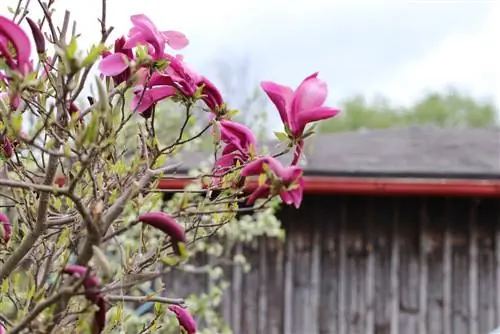
Magnolias are beautiful trees, but they can cost a lot of money in specialist stores. If you have the opportunity, you can also propagate your magnolia tree yourself.
Growing from seeds
After flowering, many magnolias produce fruits in which seeds ripen. However, the seeds are surrounded by a germination-inhibiting coating that must first be rubbed off with a little sharp sand and water. Since magnolia trees are cold germinators, the seeds must first go through a cold period. To do this, they are placed in a bag with moist sand in the refrigerator for several weeks.
- after about four weeks the first seeds begin to germinate
- Take seedlings out of the bag and place them in moist substrate
- Substrate: cactus soil or growing soil
- partially shaded location without direct sun
- Temperature: 15 to 20 degrees
- Put remaining seeds back in the fridge
Winter cool but frost-free in the first year. The following spring, the young plants can be planted outdoors in a protected location.
Propagation via cuttings
For deciduous magnolias, the cuttings are cut in early summer after flowering. The shoots of the evergreen magnolia may only be removed a little later, i.e. in late summer to early autumn.
- Cut the shoot tip of a he althy, strong shoot
- this should only be slightly woody
- Length: about 10 to 15 cm
- remove lower pair of leaves
- Scrape the bark in the lower area lightly with a knife
- put in moist potting soil
- cover with a clear plastic bag
- place in a partially shaded place (protected from the midday sun)
Once the cutting has formed roots, the plastic bag can be removed. The cutting must continue to be kept slightly moist without causing waterlogging. After about four weeks, the young plant can be repotted in humus-rich soil. However, the plant should be kept frost-free for the first winter.
Wintering
Basically you can say that most of the magnolia varieties we offer have a certain degree of frost resistance, which is why they can be planted in the garden without any problems. Evergreen magnolias are somewhat more sensitive, although there are now a number of varieties that survive our winters without damage. As a precaution, all magnolia trees that are not cultivated in mild locations should receive comprehensive winter protection. Since the roots are just below the surface of the soil, they can easily freeze. Young plants in particular are still somewhat sensitive.
- Mulch soil well in autumn
- preferably in several layers of mulch, leaves and brushwood
- Wrap tree trunks with fleece
- If the ground is frozen and there is strong sunlight, place a sack or fleece over the crown
Tip:
Young magnolia trees are usually sensitive to strong sunlight in the winter months. They should therefore be covered with a jute sack or fleece on clear days.
Types of magnolias
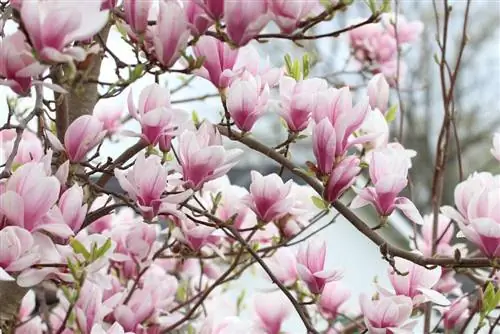
For our climatic conditions in Central Europe, a wide variety of species are suitable for cultivation in the garden. From a horticultural perspective, these magnolia trees can be divided into different groups:
Flowers before the leaves emerge (blooms in April)
- Kobushi Magnolia (Magnolia kobus): Magnolia tree with growth heights of up to 10 m, the white petals are narrow in shape and open very wide, sufficiently hardy
- Lily magnolia (also called Yulan magnolia, Magnolia denudata): usually grows like a shrub up to 6 m high and wide, white flowers with pink throat
- Purple magnolia (Magnolia liliiflora): low-growing shrub (up to 3 m), tulip-shaped flowers, purple on the outside, white on the inside
- Star magnolia (Magnolia loeberni): in contrast to the Magnolia stellata of the same name (also known as star magnolia), it does not grow as a shrub, but as a tree with heights of up to 8 m, narrow petals, good winter hardiness
- Willow-leaved magnolia (Magnolia salicifolia): deciduous tree up to 10 m tall, conical growth, lanceolate leaves, narrow, white petals, requires acidic soil
Flowers after the leaves emerge (May/June)
- Mountain Magnolia (Magnolia fraseri): deciduous tree with a height of 8 to 10 m (in exceptional cases up to 20 m), creamy white flowers with a diameter of 10 to 20 cm, sufficiently frost hardy, prefers acidic soils
- Cucumber magnolia (Magnolia accuminata): grows as a deciduous tree up to 20 m tall, the wild form produces 5 cm long, cucumber-shaped red fruits, flowers in yellow-green, prefers acidic soils, But also tolerates calcareous soils, extremely winter-hardy magnolia tree
- Umbrella magnolia (Magnolia tripetala): deciduous, often multi-stemmed tree, grows up to 10 m high, large leaves at the end of the shoots form an umbrella, creamy white flowers with narrow petals, fragrant, pink fruits, very hardy
- Siebold's Magnolia (also called summer magnolia, Magnolia sieboldii): tree from Japan with heights of up to 7 m, more commonly available as a shrub, white tulip-shaped flowers appear late (June) and hang slightly, requires acidic soil
- Honoki magnolia (Magnolia obovata): deciduous tree with heights between 15 and 25 m, upright, light yellow flowers, good frost resistance
Special types of magnolias
Evergreen magnolia (also called large-flowered magnolia, Magnolia grandiflora):
- white flowers from May to July, up to 25 cm in diameter
- depending on the variety between 8 and 25 meters tall
- some varieties are not frost resistant
Campbell's Himalayan magnolia (also soft-haired Himalayan magnolia, Magnolia campbelli)
- deciduous tree with a wide, conical crown
- Growth heights up to 15 m
- fireplace red flowers up to 20 cm in diameter in February
- comes from Nepal
Not hardy enough for us (down to -7 degrees)
therefore better suited for mild winter regions
Diseases and pests
The right location is crucial for the he alth of the magnolia tree. Well-grown magnolias are very robust when it comes to diseases. Nevertheless, the wood can be attacked by pests or pathogens. Most commonly found on magnolias:
Mildew
While powdery mildew occurs preferentially in dry heat periods, downy mildew is mainly found in persistent moisture. Yellowish to grayish spots and curled leaves indicate an infestation. The best chances are if the damaged shoots are removed early. There are also various chemical or biological means of combating it.
Leaf spot disease
This disease is caused by the bacterium Pseudomonas syringae, which mainly occurs in cold, damp weather. An infection can be recognized by the black spots on the leaves. Infected shoots can die completely. Therefore, these twigs and branches must be cut back to he althy wood at an early stage. Since the bacteria overwinter in the leaves, they should be carefully removed in the fall and disposed of with household waste.
Whitefly
This pest lays its eggs on the underside of the magnolia leaves. The larvae feed on the leaf juices and cause lasting damage to the tree. Whiteflies can be controlled with natural predators such as parasitic wasps (available from specialist retailers).
Conclusion
Magnolia plants are among the most fascinating flowering plants in our gardens. Every year they delight their gardeners with a veritable sea of flowers. A suitable magnolia is available for almost every garden, whether as a huge solitary plant in large gardens, as a flowering shrub for smaller areas or as a pot plant for terraces and balconies.

